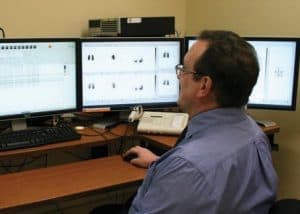Telemedecine in the age of the Covid-19 pandemic

By Grégoire Blais MD, FRCP
Médecin nucléiste / Nuclear Medicine Specialist Centre de santé et de service sociaux de la Haute-Yamaska Granby, Québec, Canada
Since March 2020 the significant « COVID-19 » pandemic has raged. From this period, there was significant confinement, social distancing and the wearing of masks were imposed. These measures have impacted on everyone’s work be- cause we were only asked to go out for essential rea- sons. Fortunately, the measures have softened over the months. However, depending on recent devel- opments of the pandemic, health measures could tighten.ince March 2020 the significant « COVID-19 » pandemic has raged. From this period, there was significant confinement, social distancing
This health crisis has greatly favored teleworking. Although already used by many professionals and companies, its use has literally exploded all over the planet. Medicine was no exception; many doctors discovered a new way of working with advantages and disadvantages. Although nothing replaces a face-to-face consultation, many of these were done by phone or virtually. Obviously, patients requiring in-person examination with a doctor was possible, but the flow to hospitals and clinics declined dramatically as expected.
In addition to the teleconsultations, many meetings, webinars, trainings and seminars were held almost exclusively in virtual mode.
In medical imaging, some procedures require the presence of a physician on site. However, a very good part of the work can be done remotely with the appropriate equipment. In both radiology and nuclear medicine, teleworking or telemedicine has been well established for several years. Whether for evening, night or weekends shifts.
Some doctors have telemedicine workstations that are just as effective in their homes as they are in hospitals or clinics. With the significant advancement in technology, these telecommuting workstations are available at reasonable prices. Most of the time, these consoles have the same functionality as in a clinical setting, i.e. dictation software, PACS, etc.
These workstations can be a tower with multiple screens or even be a laptop or tablet. This last option therefore makes it possible to telework anywhere.
When the pandemic started, it was quick and easy to telecommute the nuclear medicine physicians and radiologists. However, the number of teleworking workstations had to be significantly increased. The main difficulty was getting the computer permissions and that was understandable given the all-out demands for teleworking.
During the pandemic, thanks to these well- established teleworking systems, imaging doctors were able to quickly adapt to containment measures. Very useful also for doctors quarantined, but able to work.
Telemedicine systems allow, in addition to teleworking from home, to connect the dedicated imaging systems of distant hospitals to each other. To do this, exchange protocols must be compatible. The usefulness of these exchanges is manifold. For example, if a site is temporarily without a doctor, exams can be interpreted by another doctor remotely. In this way, we avoid moving a patient and having service disruptions. Also, two doctors standing miles apart discussing a complicated case.
Since the beginning of the pandemic, university hospitals have had to deal with the proximity of residents and specialists in the reading rooms. To respect social distancing, in many cases the supervision of residents had to be done remotely (room nearby or in another establishment). Once again, thanks to a well-established telemedicine in imaging, the deployment of the technology was able to be done quickly to avoid a breakdown in supervision.
In the mid-2000s, the government of the province of Quebec wanted to establish an interface between the various PACS systems in the province. This link between the different PACS systems was supposed to make it possible to exchange imaging examinations in a fluid way between the different healthcare establishments in Quebec. Unfortunately, fifteen years later the exercise was not successful, and mainly in nuclear medicine. At the same time, an IT group dedicated to computing in nuclear medicine, the HERMES SOLUTIONS MEDICALES group, has gradually developed a network of HERMES users in numerous nuclear medicine units in Quebec. These different departments with this computer system can easily exchange data, regardless of the data complexity. One of the advantages of this computer platform is that it can collect data from different companies working in nuclear medicine. Such a network of users of this system is precious, especially during a pandemic. Having a large number of connected users prevents uncovering, helps consultation between colleagues and helps to carry out multicentre research projects.
This period of pandemic brought new paradigms in hospital work as well as in other spheres of work. In medicine, telecommuting has become a new norm that will not go away when the pandemic is over. In medicine, teleconsultation is very useful, but it does not replace an entire face-to-face visit. Some scientific meetings or training will take place virtually. In imaging, teleworking was well established before the pandemic, but it was a great opportunity to consolidate it. Medically, we will be better prepared if there is a new wave of COVID-19.



